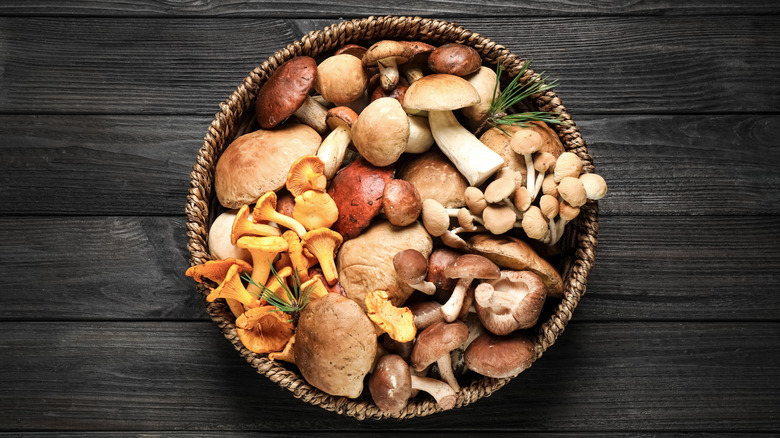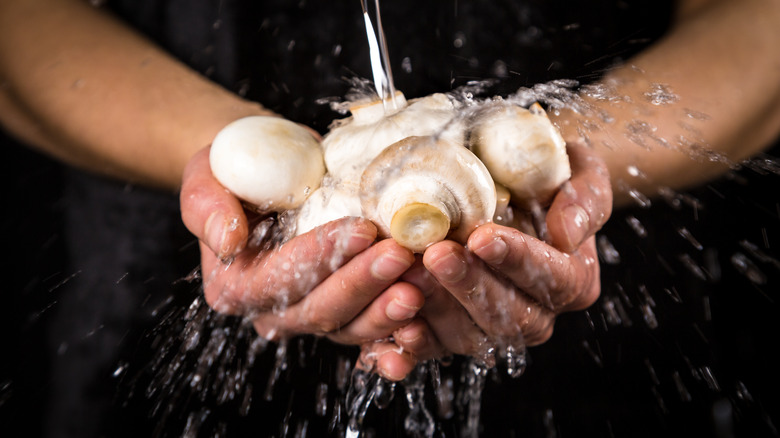The Best Way To Clean Mushrooms
At some point in your culinary education, you probably heard that you should never wash mushrooms. They're porous, so they absorb too much moisture and become mushy, the theory goes. But then you see something like Julia Child washing 'shrooms as she's making boeuf bourguignon, and suddenly everything you thought you knew goes out the window.
Not surprisingly, the matter of whether or not a cook should wash mushrooms is a polarizing subject among experts — including the 12 we asked. "It's a controversial question," allows Candy Argondizza, vice president of culinary and pastry arts at the International Culinary Center, who counts herself in the "sometimes wash" camp.
Bisou Bistronomy chef Nicolas Ronan doesn't use water to clean mushrooms at his San Francisco restaurant to avoid "damaging the produce." Instead he keeps a variety of paintbrushes on hand to gently brush the fungus clean. Dallas chef Kyle McClelland of Proof + Pantry uses a can of compressed air to clean morels.
But Becky Selengut, veteran chef of The Herbfarm restaurant and author of "Shroom: Mind-bendingly Good Recipes for Cultivated and Wild Mushrooms," says it's fine to wash them. "It's a myth that mushrooms absorb too much water and turn to mush," she says. "The problem is really insufficient heat. If you crowd them in a pan over too low heat, you can watch as the water starts kicking out."
To wash or not to wash? Mushroom cleaning advice from the pros
When it comes down to it, turns out most pros are in the "sometimes" camp. Whether to wash or not depends on the type of mushroom, how it was grown and the way it will be cooked, among other things. Here's what we learned.
When to wipe: For cultivated mushrooms, such as button, cremini and portobello, most chefs say it's fine for home cooks to simply wipe clean with a damp paper, dish towel, or soft brush. Chefs Jake Linzinmeir and Chris Thompson of The Nickel in Denver recommend a soft shaving brush and a stiffer tooth or nail brush for the task. Similarly, wipe or brush shiitakes, hon-shimeji, cinnamon caps, beech, hen-of-the-woods, and oyster mushrooms, chef Anthony Van Camp of Dallas's SER Steak says. Trim off any woody stems — but don't toss them, says chef Ignacio Lopez from Cambridge, MA's Beat Hôtel, who saves them to add umami to stock.
When to wash: Cultivated mushrooms are grown in fairly controlled environments. Wild mushrooms are not — and they've got the dirt (and sometimes manure) to prove it. You'll definitely want to give these mushrooms a wash to dislodge grit and eliminate pathogens. Morels, with their honeycomb caps, and open-footed black trumpets are notorious for trapping all manner of debris. Place in a bowl of cold water, agitate, skim any debris that might rise to the top, then lift out with your fingers (never pour or the dirt will get right back in) and dry. Repeat as often as necessary, but avoid letting them soak. Use a microfiber towel to pat the fungi dry or take a page from Lopez, who pats dry, spreads mushrooms on a baking sheet and places in the refrigerator, where the air is drier.
When not to: Though matsutake and porcini mushrooms are wild, most chefs advise against washing them — they're just too darned expensive to risk damaging. Instead, peel their stems and remove any impurities with a paring knife, then gently wipe clean with a damp towel or brush, chef Blaine Staniford of Grace in Fort Worth suggests.
And, of course, if a mushroom is slimy or smells funky (which often happens if they're stored in plastic), no amount of washing or brushing will make it right. Toss 'em and hope for better timing next go-round.

